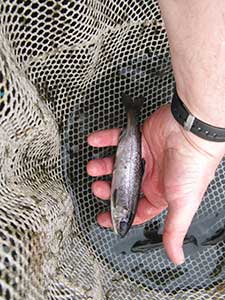By Louie Stout
 Indiana has begun stocking larger-than-normal coho into the St. Joseph River. (DNR photo)If you normally wait until April to start hitting the St. Joseph River for steelhead, you might want to expedite those plans.
Indiana has begun stocking larger-than-normal coho into the St. Joseph River. (DNR photo)If you normally wait until April to start hitting the St. Joseph River for steelhead, you might want to expedite those plans.
The mild March weather has drawn hundreds of fresh fish into the South Bend/Mishawaka area and river conditions have been favorable for fishing.
“It’s been a good March,” said Lake Michigan biologist Brian Breidert. “We typically don’t see this kind of push of steelhead until April.”
Nearly 3,500 steelhead have been counted at the South Bend fish ladder since Jan. 1. The biggest push came from March 17 to March 23 when nearly 1,200 fish moved up river.
The run is a welcome sight for river anglers following a dismal 2015 fall run of trout and salmon. Breidert said the early steelhead run should have some steam ahead of it and expects another 1,500 or so fish to come in to spawn.
Dick Parker of Central Park Bait in Mishawaka said fishing has been very good this week. Several steelhead are being caught up and down the river, with spawn, wax worms and Hot’n Tot crankbaits producing the lion’s share.
“There were some fish moving onto gravel but the cooler weather has pushed them back,” Parker said.
Trail Creek in Michigan City has seen similar results. Breidert said some Trail Creek anglers are calling this the best spring steelhead fishery they’d seen in years.
The fish aren’t giants, averaging 6 to 10 pounds, somewhat below average for spring fish. The reason, Breidert said, is the low forage base that the fish have available to them in Lake Michigan.
He and others remain extremely concerned about that Lake Michigan forage. Alewife numbers have plummeted in recent years and it doesn’t look like this summer will be any better.
“It doesn’t look good at all,” said Breidert. “With the salmon and other fish species out there feeding on alewives, the forage base is in dire straits. We’re on the ropes.”
Without a sufficient forage base, young fish have less to eat and grow slower. There will be fish to catch in the big lake this year, but Breidert predicts fishing will be tougher.
“The biomass of prey fish is at an all-time low,” Breidert explained. “While the forage numbers in 2014-2015 were up some, the 2010 alewife class has pretty much disappeared.”
There are a couple of bright spots. Last year’s perch spawn was highly successful, but how well those fish survived through the winter remains in question. It’s possible that some of the salmon gorged themselves on young perch when there weren’t alewives around to eat. We’ll know more about that in June and July.
In addition, coho fishing has been good around the Indiana harbors. Breidert said some nice 2 to 4-pound cohos have been caught this spring by boat and shore anglers.
Future coho fishing could get even better. Indiana is stocking some 60,000 larger size fish into the St. Joseph River this week in an experiment which should give the fish a better head start. Historically, Indiana plants coho in the fall but the fish going in this week were held over at the hatchery and will be an inch or more larger than the normal stocking size. The 16-month old fish will run 7.5 to 9 inches. Some of those may mature quicker and contribute to next fall’s coho run into the river.
Anglers who hook the small coho should take extra care in handling and releasing them back into the river.





